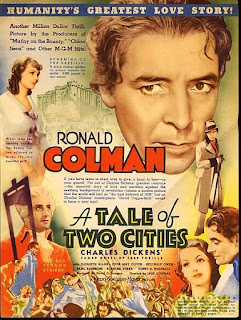
Banker Jarvis Lorry (Claude Gillingwater) meets with Lucie Manette (Elizabeth Allen) to inform her that her father, who she thought was dead, is alive. A prisoner in the Bastille in Paris for over 18 years, Dr. Manette (Henry B. Walthall) has almost lost his mind, but his love for his young daughter helps him to be "recalled to life". On a ship back to England, the Manettes meet Charles Darney (Donald Woods), who is, unbeknownst to them, is the nephew of the man who caused Dr. Manette's imprisonment, the Marquis St. Evremonde (Basil Rathbone). Our film this week is the David O. Selznick production of Dicken's A Tale of Two Cities (1935).
David O' Selznick became famous for adapting novels for the screen (think Rebecca (1940), Gone With the Wind (1939), David Copperfield (1935), Anna Karenina (1935)). When working on Gone With the Wind, he was quoted as saying "the book is the law, the book is the Bible" (Film Adaptation and Its Discontents: From "Gone with the Wind" to "The Passion of the Christ" by Thomas Leitch), and with one small exception, this is true of A Tale of Two Cities. Based on the novel by Charles Dickens, the story paints a picture of Paris leading up to and during the Terror.
The one big change from the novel was forced by the casting of Ronald Colman as Sydney Carton. He is, of course, magnificent in the part; his mellifluous voice provides a perfect ending to the film, as Sydney tells us "It is a far, far better thing I do than I have ever done; it is a far, far better rest that I go to than I have ever known." (it gives me chills very time I hear it). But Mr. Colman was adamant about one thing - he did not want to play both Sydney and Charles Darney. (AFI catalog). Though Mr. Selznick was later quoted as saying Mr. Colman "had a dread of dual roles", Selznick would convince him two years later to perform in The Prisoner of Zenda as both the King and as Rudolf Rassendyll. Yet, the casting of two different actors works well, and makes Carton's efforts at the end of the story even more poignant.
It is fair to say that this is a film without any false performances. The supporting cast is excellent, featuring some of Hollywood's greatest character actors. Blanche Yurka, as Madame De Farge gives a frightening performance as a woman obsessed with the demise of the aristocracy. Notorious for her knitting skills, Madame is making a blanket with the coats of arms of all the aristos she plans to execute. My friend noticed that Ms. Yurka was "throwing" her yarn in the English fashion (and in fact, was not really knitting - the needles never moved), which ended in a discussion about when would a knitter in France have knitted Continental style? The answer was in the early 19th Century (A History of Hand Knitting by Richard Rutt), what we now call the continental style was introduced to the rest of Europe from Germany, so it is likely that, in the 1790s, Madame would indeed have thrown her yarn.
Madame is a good companion to Lucille La Verne as The Vengeance, an odious woman, equally maniacal in her desire to murder. Ms. La Verne was at one point in the running to play Madame De Farge, along with Judith Anderson, May Robson, and Emily Fitzroy. Two years later, Ms. La Verne would be the inspiration and voice for the Queen/Witch in Snow White and the Seven Dwarfs. You can hear her doing that insane laugh in this film as well.
Also outstanding is the always entertaining Edna May Oliver as Miss Pross. A determined lady whose life is devoted to the protection of her "Lady Bird," Lucie and Lucie's family, we know from the start that nothing will prevent Miss Pross from seeing the Manettes home to safety in England.
Basil Rathbone has a relatively small part - that of the Marquis St. Evremonde. He is so totally despicable that you look forward to his eventual death. The only problem is that you don't get to see him any longer and he is so very good in the part, giving just the right amount of swagger and disregard to a horrible man.
Isabelle Jewell has a small but important part of a Seamstress swept up in the madness of the Terror. We see her once at trial, and then again in prison. She plays it well - though only introduced to the woman, you feel for her, and ultimately admire her courage. Though director Jack Conway was convinced she would not fit the role, David Selznick disagreed, and insisted on testing her. All parties were convinced by her test, and Ronald Colman got permission to give her the good news. (TCM article)
Colman portrayed Carton again on two Lux Radio Theatre broadcasts, on 12 Jan 1942 (with Edna Best) and 18 Mar 1946, (with Heather Angel). Orson Welles took on the role for a 26 Mar 1945 Lux Radio Theatre broadcast. The story has been on film multiple times. There was a silent version in 1917; William Farnum played both Sydney and Charles. In 1958, Dirk Bogarte appeared as Sydney; and a 1980 television movies featured Chris Sarandon as both Carton and Darnay. Two television miniseries have also been produced - one in 1980 with Paul Shelley in the double role and a 1989 version with James Wilby as Carton.
The New York Times review by Andre Sennwald called the movie "a prodigally stirring production. . . .for more than two hours it crowds the screen with beauty and excitement. . ." We wholeheartedly agree, and leave you with a trailer:




It's banker Jarvis Lorry (Claude Gillingwater) who meets with Lucie Manette. John Barsad is a spy for the Marquis St. Evremonde.
ReplyDeleteThanks for letting me know of the error. I corrected it.
Delete